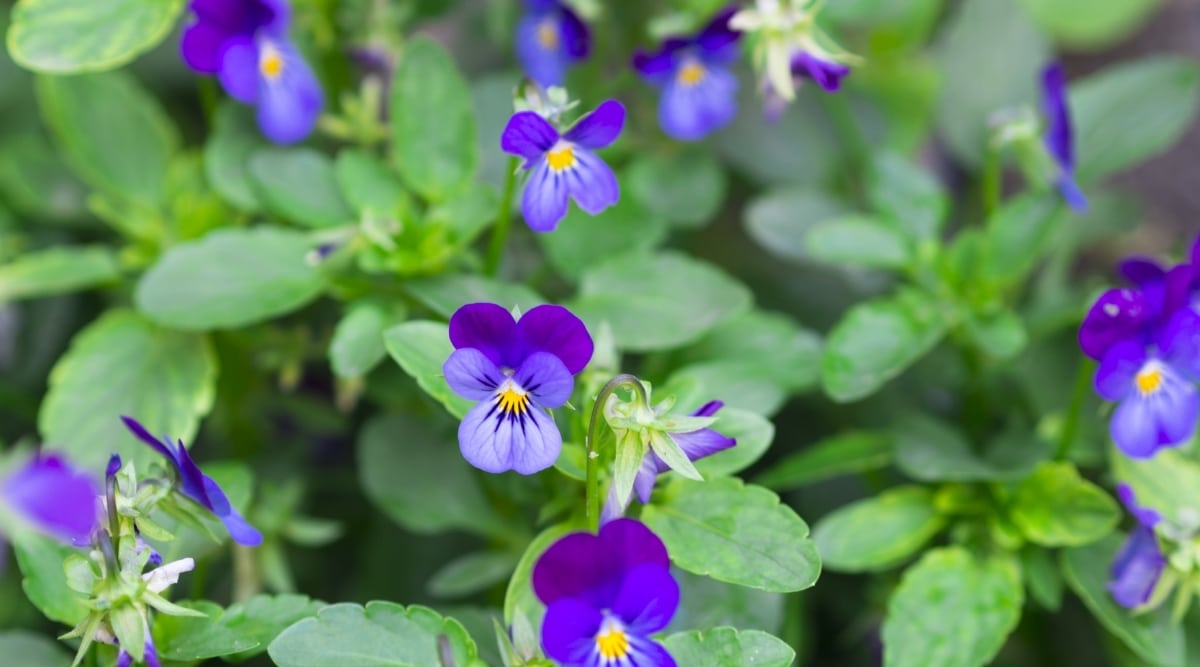HOME IMPROVEMENT
What are the Weeds with Purple Flowers Called?

Who doesn’t like pretty purple flowers? In their proper place, purple flowers and the plants that produce them are lovely. However, when they start to over-run your lawn or crowd out the plants in your garden, these purple flowering plants become weeds. To complicate the issue, a number of weeds have purple flowers, so identifying what you’re dealing with in your lawn or garden can be tricky. If you’re asking “What are the weeds with purple flowers called?” I’ve got you. Today I’ll introduce you to the 4 most common weeds with purple-colored flowers and help you understand how to control and eliminate them from your lawn and landscape.
Four Nasty Weeds Bearing Purple Flowers
Honestly, there are a number of harmful weeds that have purple flowers. They’re beautiful, but not when they’re in the wrong place (like your lawn).
The following four weeds with purple flowers are probably the most notorious culprits responsible for invading your landscape:
- Creeping Charlie (Ground Ivy)
- Purple Deadnettle
- Henbit
- Wild Violet
Let’s take them one at a time so you can identify the purple flower weed in your lawn or garden, but first a word about eliminating these weeds.
How to Kill Purple Flowering Weeds
Hand-pulling is the best organic method for eliminating most weeds, and spraying with a vinegar solution can also work as an organic method.
Herbicides are the most effective method if you’re open to using them. Be sure to wear PPE (personal protective equipment) and follow all safety recommendations from the manufacturer.
Most of the weeds with purple flowers you’ll encounter fall under the “broadleaf weed” category. As such, Dicamba will work to kill most of these plants. I use and recommend this product from Southern Ag. It’s my go-to lawn herbicide for most broadleaf weeds. But you can find effective options locally at hardware and box stores as well. Look for something marked for broadleaf weed control.
Creeping Charlie (Ground Ivy)
What is it?
Creeping Charlie, also known as Ground Ivy, is a broadleaf weed from the mint family. This branching weed grows about one inch high and quickly becomes a low-growing mat of stems and leaves scattered around your yard.
Chances are this fast-spreading weed is the culprit responsible for those purple blooms scattered throughout your yard. Many people battle it in their lawns.
At first glance, Creeping Charlie’s delicately scalloped leaves and blue-violet spring flowers appear to be quite tolerable, but don’t be fooled. Creeping Charlie is a resilient and adaptive vine that can quickly overtake a lawn and kill the turf-grass around it.
Part of this weed’s resilience lies in the fact that it is not vulnerable to pests and diseases. So just hoping it will go away will result in a quickly spreading predator capable of choking the life out of your lawn.
While Ground Ivy is an undesirable weed, its delicate purple flowers have one redeeming quality. In the proper conditions, these blooms attract Honey bees, Bumblebees, and Mason bees. Supporting pollinators is great, but let’s be honest … there are better ways to do it.
Where does it grow?
Creeping Charlie is hardy in zones 2 – 12, making it a nuisance nearly everywhere. Because this weed is exceptionally resilient, it thrives in some of the most unsavory conditions. However, it prefers partial sun and moist, fertile soil.
Like most lawn weeds, Creeping Charlie seems to prefer unhealthy lawns. Therefore, regular mowing, watering, and fertilizing is one of the best ways to prevent it from appearing in the first place. When healthy, well-fed grass grows extra thick, it leaves no room for weeds like Creeping Charlie.
How do I get rid of it?
Even though Creeping Charlie is considered a broadleaf weed, it is not affected by all broadleaf herbicides. Most methods of tackling this nuisance are somewhat ineffective because what’s seen on the surface is only part of the problem.
This variety of weed has vining rhizomes underground that are especially troublesome to kill. Unfortunately, the best way to eradicate this pest from your yard is to use a pro-level herbicide like Dicamba.
Natural methods such as placing a tarp over the affected area and starving the Creeping Charlie of sunlight will also work. Unfortunately, the tarp will also deprive the grass and other plants of light. For smaller infestations, good old-fashioned hands knees pulling is an effective elimination method for Creeping Charlie.
Purple Deadnettle
What is it?
Lamium purpureum, or Purple Deadnettle, is another pesky weed that is derived from the mint family. This common weed is characterized by its purplish-pink flowers, but more so by its stem and leaves.
The square-shaped stem has a lower and upper section. The lower section is entirely devoid of foliage, yet the upper part bears purplish-colored leaves with triangular tips. These leaves have petioles or stem, that connect them to the main stem.
Where does it grow?
Purple Deadnettle prefers a quite unsavory habitat. It can thrive in moist areas such as drainage ditches, fallow fields, waste areas, and weedy edges of woodlands.
Preferring these types of places initially makes Purple Deadnettle no significant threat for your lawn. However, if your yard is typically moist (say, from an irrigation system) and possibly close to a field or woodland area with a Purple Deadnettle infestation, then your yard could be at risk.
How do I get rid of it?
Prevention is vital with Purple Deadnettle. This weed is a winter annual, meaning if you can stop seed production in the spring, your problem is solved. Herbicide application is an effective elimination method if applied in the early spring before Purple Deadnettle begins to bloom.
However, if you prefer to try organic ways of ridding your acreage of weeds, tillage in the late fall and again in the early spring is a decent solution. Understandably, you won’t want to till your entire lawn. But the reality is that Purple Deadnettle is most likely not going to attack your grass lawn, rather the edges and small sections here and there on your property where conditions are favorable.
This pest will rear its ugly head in places like your garden plot or around your yard’s perimeter. In these areas, organic tillage or even solarization is ideal.
Henbit
What is it?
Henbit also has the signature purple flowers these other weeds possess. At first glance, it could be confused with Purple Deadnettle, but there are some telltale differences.
Henbit has the same type of square stem that divides into two sections. However, it has more rounded leaves with deep lobes. Unlike Purple Deadnettle, the leaves on the upper stem do not have petioles. Instead, they are directly attached to the main stem.
Probably the most apparent visual difference between Purple Deadnettle and Henbit is that Henbit leaves have a “hairy” appearance.
Where does it grow?
Henbit is another widespread weed that will most likely appear around the edge of your yard, in fields, fallow areas, next to buildings, or your garden.
It is not generally a weed that will take hold of your actual lawn, so if you have purple flowering weeds in your grass, Henbit probably isn’t what you’re dealing with.
How do I get rid of it?
Because Henbit spreads through seed production, preventing those seeds from forming will greatly assist in controlling this weed.
Herbicide application in the early spring is probably the most effective way to cripple seed production in Henbit. However, I should note that if you wait until the pretty purple flowers appear, you’ve waited too long and herbicides won’t be effective.
Even your most powerful herbicide is no longer useful once the plant begins to bloom.
Organic methods to eliminate this weed are pretty standard. You can control small patches with hand pulling Henbit. Just be careful to control inadvertent seeding by carefully pulling the plants and putting them in a bucket or sack. Do not leave them on the ground.
Larger infestations of Henbit are manageable with early spring and fall tillage, the same as Purple Deadnettle.
Wild Violet
What is it?
The verdict is out on this particular plant. Some people affectionately refer to it as a flower, yet others passionately detest its presence. For our purposes (looking at its presence in a lawn), it is a weed.
This perennial bloomer has deep green heart-shaped leaves and delicate stems. These stems support a rather pretty purple flower, of course.
Where does it grow?
Wild violet prefers a moist, shady environment; however, mature plants are drought tolerant. This detail means wild violet can originate in an ideal place in your yard (like under a tree or near a shaded downspout) but spread to just about anywhere it wants in one of two different methods.
The unattractive aspect of wild violet is that it spreads prolifically two ways. First, it can propagate from seeds that form in low bearing flowers that do not open. These seeds can end up nearly anywhere by way of rainfall and wind.
Wild violet also spreads by rhizomes under the ground. People who battle this weed will tell you it mostly ends up in places it is not welcome. Worse yet, wild violet is quite resilient. Amazingly, it adapts to mowing by growing shorter so it can dodge the blade and give itself ample time to develop seeds.
How do I get rid of it?
As with most of these purple flowering weeds, eradication involves an appropriate herbicide or hand pulling.
Because wild violets have both seeds and rhizomes, be extra careful to dispose of the pulled waste properly, so regrowth does not occur.
Additionally, the hand-pulling method will most likely require several sessions, so be vigilant and patient.
When Purple Flowers Aren’t Pretty
Looking out over your yard or garden, you want to be sure the pretty purple flowers you see are intentional, and growing where you want them.
When purple flowering weeds become a problem, there are solutions to eradicate them and prevent them from returning.
Whether it’s Creeping Charlie, one of its friends from the mint family, or wild violet, there is hope for eliminating that undesirable purple hue from your yard.
Identifying the weed you’ve got is the first step toward a weed-free lawn or garden.








